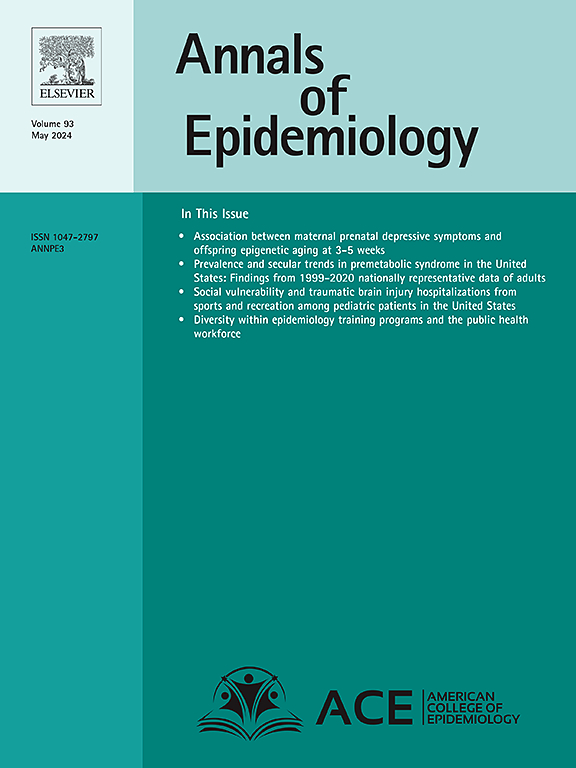Joint associations of physical activity and body mass index on the prevalence of hypertension among a nationally representative sample of 1.9 million U.S. adults: A cross-sectional study
IF 3
3区 医学
Q1 PUBLIC, ENVIRONMENTAL & OCCUPATIONAL HEALTH
引用次数: 0
Abstract
Purpose
This study examines the joint associations of physical activity (PA) and body mass index (BMI) on the prevalence of hypertension in a nationally representative sample of 1.9 million U.S. adults.
Methods
Data were pooled from five U.S. Behavioural Risk Factor Surveillance System surveys from 2011 to 2019. Cross-sectional associations between self-reported PA and BMI status (independent variables) and hypertension (dependent variable) were analysed using Poisson log-linear regression with a robust-error variance, reported by adjusted prevalence ratios (APRs).
Results
Data was available for 1,909,597 individuals (≥18 years). Compared to normal weight, highly active individuals (reference category), there was an association with decreased PA, increased BMI and prevalence of hypertension. Adjusted prevalence ratios (APRs) ranged from APR= 1.05, 95 % CI= 1.05–1.05 (Non-Active, Normal Weight) to APR= 1.83, 95 % CI= 1.82–1.83 (Non-Active, Obesity Class III).
Conclusion
A high body mass and low levels of PA were associated with a substantially increased prevalence of hypertension. Being highly active was associated with minor differences in the prevalence of hypertension for individuals who were living with obesity; however, this association was not observed among those who were living with normal weight or overweight. Due to likely bias in this cross-sectional study, findings regarding PA should be replicated in longitudinal studies with objective measures. These findings nonetheless highlight the public health relevance of maintaining a healthy body weight in relation to hypertension prevalence and the importance of PA for weight loss and management.
在190万美国成年人的全国代表性样本中,身体活动和身体质量指数对高血压患病率的联合关联:一项横断面研究。
目的:本研究在190万美国成年人中调查了身体活动(PA)和身体质量指数(BMI)与高血压患病率的联合关系。方法:数据汇集自2011年至2019年美国行为风险因素监测系统的五项调查。采用校正患病率(APRs)报告的泊松对数线性回归分析自我报告的PA和BMI状态(自变量)与高血压(因变量)之间的横断面关联。结果:获得了1,909,597例(≥18岁)的数据。与正常体重、高度活跃的个体(参考类别)相比,PA降低、BMI升高和高血压患病率存在关联。调整患病率比(APR)范围从APR=1.05, 95% CI=1.05-1.05(非运动,体重正常)到APR=1.83, 95% CI=1.82-1.83(非运动,肥胖III类)。结论:高体重和低PA水平与高血压患病率显著增加相关。在肥胖人群中,高运动量与高血压患病率的微小差异有关;然而,在体重正常或超重的人群中没有观察到这种关联。由于该横断面研究可能存在偏倚,有关PA的发现应在具有客观测量的纵向研究中得到重复。尽管如此,这些发现强调了保持健康体重与高血压患病率的公共卫生相关性,以及PA对减肥和管理的重要性。
本文章由计算机程序翻译,如有差异,请以英文原文为准。
求助全文
约1分钟内获得全文
求助全文
来源期刊

Annals of Epidemiology
医学-公共卫生、环境卫生与职业卫生
CiteScore
7.40
自引率
1.80%
发文量
207
审稿时长
59 days
期刊介绍:
The journal emphasizes the application of epidemiologic methods to issues that affect the distribution and determinants of human illness in diverse contexts. Its primary focus is on chronic and acute conditions of diverse etiologies and of major importance to clinical medicine, public health, and health care delivery.
 求助内容:
求助内容: 应助结果提醒方式:
应助结果提醒方式:


